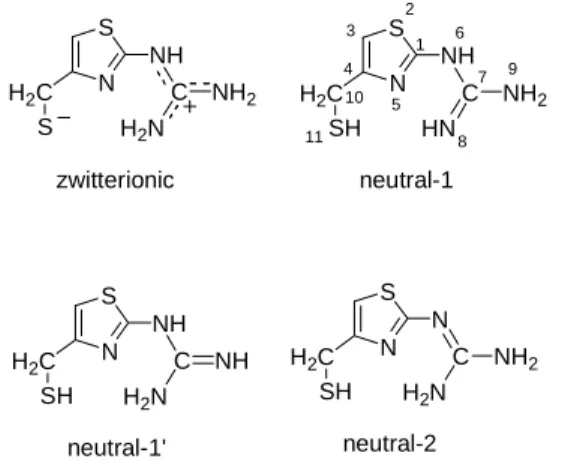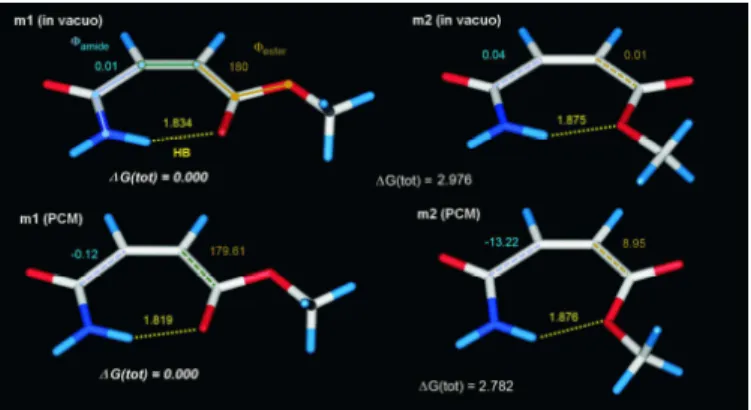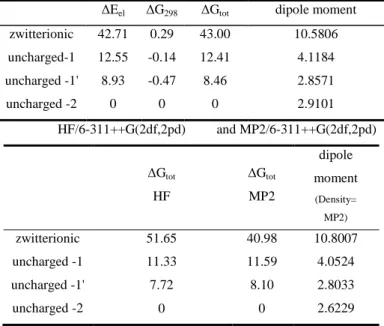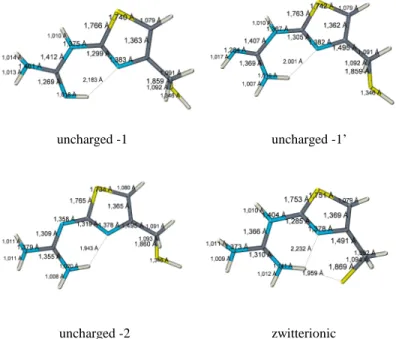Quantumchemical Interpretation of Regioselectivity in Michael-additions and
Protonations
Theses of doctoral (PhD) dissertation
Ákos Rácz Semmelweis University
Doctoral School of Pharmaceutical Sciences
Supervisor: Dr. Béla Noszál, Ph.D., D.Sc.
Opponents: Dr. Gábor Pongor, Ph.D., C.Sc.
Dr. Levente Herényi, Ph.D.
Head of examination committee:
Dr. Éva Lemberkovics, Ph.D., C.Sc.
Members of examination committee:
Dr. László Lázár, Ph.D., C.Sc.
Dr. Erika Balog, Ph.D.
Dr. Gábor Dibó, Ph.D., C.Sc.
Budapest 2014
1
Introduction
The Michael additions of α,β-unsaturated dicarboxylic acids and their derivatives are commonly used in the syntheses of amino- dicarboxylic acids. Several methods have been developed in the Department of Pharmaceutical Chemistry, Semmelweis University, starting from maleic and fumaric acid derivatives (ester, amide, anhydride), developing thus selective syntheses of the amide and ester derivatives of N-methyl-aspartate and N-methyl-isoaspartate.
In these reactions, however, regioselectivity and its interpretation remained a crucial question for a long time.
Famotidine is one of the most widely used gastric acid inhibitors, despite its old-fashioned nature. It is a major question, if its guanyl- thiazole moiety protonates on the thiazole ring or on the guanyl site.
Starting from propositions based on experimental and semiempirical theoretical results found in the literature, ab initio calculations were performed on the protonation isomers of the N-(4-mercaptomethyl- thiazolyl)-guanidine according to energetical relations and the presence of intramolecular hydrogen bonds.
2
Objectives
Regioselectivity of the Michael addition of ammonia on methyl- maleamate
The addition of ammonia and substituted primary amines to methyl maleamate (m) may lead to two reaction products (Fig. 1.), forming amino group on the vinylogue carbon of the ester group results in production of isoasparaginates (i), the attack on the vinylogue carbon of the amide group leads to asparaginate (a) derivatives. The formation of methyl asparaginate was only found in the case of ammonia, the reaction with any other amine led exclusively to methyl isoasparaginate (by 1H NMR spectrum of product mixture).
Fig. 1. Michael addition of ammonia on methyl-maleamate The purpose was to reveal the reasons of regioselectivity stemming from structural, electronic and thermodynamical reasons. It was necessary to do calculations on the starting α,β-unsaturated dicarboxylic acid mixed ester/amide, on the reaction products, and on the possible transition states as well. As simplest model, the additions of the ammonia were investigated.
C C
C O
O CH3
O C N
H H
H H
C C
C O
O CH3
O C N
H H
H H
N H H
H C C
C O
O CH3
O C N
H H
H H
H N
H H
NH3 NH3
m
i a
a b
CO,ester CO,amide
am sp3
sp2,ester
b a
methyl sp2,amide
NH3
am
NH3
am ,
3
Geometry and charge distribution of the gross neutral protonation forms of N-(4-mercaptomethyl-thiazolyl)-guanidine
N S
NH C NH2 H2N H2C
S
N S
NH C NH2 HN H2C
SH
N S
N C NH2 H2N H2C
SH zwitterionic neutral-1
neutral-2
1 2 3 4
5 6
7
8 9 10
11
N S
NH C NH H2N H2C
SH neutral-1'
Fig. 2. The investigated protonation forms of N-(4-mercaptomethyl-thiazolyl)-guanidine
The relative energies and charge distributions of four protonation isomers of N-(4-mercaptomethyl-thiazolyl)-guanidine - as models of the correspondig structural unit in famotidine - were investigated:
one zwitterionic and three non-charged ones (Fig. 2.).
4
Methods, instruments
The calculations were performed by a SGI Octane workstation, and for transition states, also by the supercomputer of the Ohio Supercomputer Center.
Regioselectivity of the Michael addition of ammonia on methyl- maleamate
The first steps were the initial MMFF94s geometry optimizations (SYBYL 7.0 software), in order to reduce the number of geometry optimization steps in the quantumchemical calculations. The quantumchemical calculations were performed by the Gaussian03 software. For methyl-maleamate, the conformational PES for the CCO,amide-Cb and CCO,ester-Ca rotating bonds was scanned in 60° steps within the [-180°, +180°] range, at the B3LYP/6-31+G(d) level, in vacuo. The quasi-minima were then fully optimized in vacuo to the m1 and m2 (Fig 3.), at the B3LYP/6-31+G(d) level and in methanol at the IEF-PCM/B3LYP/6-31+G(d) level. The m3 and the m4 conformers (Fig 4.), as well the product structures were fully optimized (the latter ones only in solvent) directly from the MMFF94s geometries. At the levels above, the thermodynamic quantities and the vibrational spectra were also calculated. The exact Eint and Etot in vacuo, and in methanol were computed at the B3LYP/6-311++G(2df,2pd) level. Molecular orbitals and partial charges (NPA, CHelpG and MKS) were calculated both with the 6- 31+G(d) and 6-311++G(2df,2pd) bases. For transition states optimizations and thermodynamics we have started from the van der Waals complexes of ammonia and m1, verifying the results of TS search by visualization of the vibrations corresponding to imaginary
5
frequencies. Eint and Etot were calculated at the IEF-PCM/B3LYP/6- 311++G(2df,2pd) and the IEF-PCM/MP2(FC)/6-311++G(2df,2pd) levels.
Geometry and charge distribution of the gross neutral protonation forms of N-(4-mercaptomethyl-thiazolyl)-guanidine
Geometries were optimized at the B3LYP/6-31++G(2d,p) level, in vacuo, and they were verified by the vibrational spectra. Energies were calculated at the B3LYP/6-31++G(2d,p), HF/6- 311++G(2df,2pd) and MP2/6-311++G(2df,2pd) levels. The in vacuo free energies ∆Gtot were calculated as the sum of ∆Eel electron- energies and the thermal corrections (T=298K) ∆G298 (kcal/mol).
Relative values were compared with the ones of the lowest energy protonation form. Charges were calculated at the B3LYP/6- 31++G(2d,p) and MP2/6-311++G(2df,2pd) levels, via Mulliken, NPA, MKS and CHelpG methods.
6
Results
Regioselectivity of the Michael addition of ammonia on methyl- maleamate
The title molecule bears rigorous structural constraints. Due to π- electron delocalization over the whole molecular backbone, high stability against rotations around the skeletal carbon-carbon single bonds (Figs. 3 and 4) is expected. In the studied C-C=C-C cis isomer, considerable repulsion is also expected between the oxygens of the end-groups in some arrangements. Such repulsion does not exist in the C-C=C-C trans isomer.
Fig. 3. Planar conformers of methyl maleamate, with the correspondig energies (investigated dihedral angles with degree values, hidrogen bond distances in Angstroms, energies in kcal/mol)
Repulsive interactions occur between two carbonyl oxygens, or between the amide carbonyl oxygen and the sp3 oxygen in the ester group. On the other hand, attractive interactions may arise due to an intramolecular hydrogen bond between an amide hydrogen and any oxygen in the ester group. Furthermore, attractive n-π* interactions
7
may come into existence in some non-planar forms, when a carbonyl oxygen lone electron pair is nearly perpendicular to the plane of the other carboxylic function, and the two moieties involved can reach the desired proximity.
Two, primarily planar minima were found both in vacuo and in methanol (Fig 3., Table 1.). The deepest minimum was found for m1 with φamide≈ 0o and φester≈ 180°. For m2 in methanol, the torsion angles deviate by about 10o.
Fig. 4. The conformers of methyl maleamate stabilized by n-π* interactions, with the correspondig energies
Table 1. Relative energies of methyl maleamate conformers in methanol (kcal/mol)
IEF-PCM/B3LYP/6-311++G(2df,2pd)//
IEF-PCM/B3LYP/6-31+G(d)
∆Eint ∆Etot ∆Gdrc ∆Gsolv ∆G298 ∆Gtot
m1 0.000 0.000 0.000 0.000 0.000 0.000 m2 5.716 3.394 0.300 3.694 -0.912 2.782 m3 5.682 1.293 0.980 2.273 -1.450 0.823 m4 6.892 1.693 0.860 2.553 -1.259 1.294
The two conformers with the carbonyl oxygen donors (referred as m3 and m4), were found in methanol (Fig. 4., Table 1.), but only m4 was found in vacuo. It is supposed that the proximity of the amide hydrogen and the sp2 ester oxygen leads to the destabilization of m3
8
and to the conversion of m1. The HOMO-2 for m3 and the HOMO for m4 nearly correspond to lone pairs of an sp2 oxygen. By drawing the electron density surface for these orbitals, the orientations of the lobes allow the oxygens acting as donor atoms for n-π* interactions.
The symmetry axes of the corresponding lone pairs on the oxygens lie in the line connecting the oxygen and the carbonyl carbon in the other group.
Charge distribution calculations of the isolated methyl maleamate can predict the site of the nucleophilic attack, The less negative charge is favorable in this respect. In terms of negativity, the relation Ca > Cb holds with all three methods for conformers m1, m2 and m3. Only the natural population analysis (NPA) method predicts slightly more negative charge for Cb in m4, but this conformer is a minor component in the equilibrium mixture.
Product conformers and relative energies
The theory could predict energetically the preference of the experimentally observed isoasparaginate product.
Table 2. Relative energies of dominant conformers of ammonia adducts of methyl maleamate in methanol (kcal/mol)
∆Eint ∆Etot ∆Gdrc ∆Gsolv ∆G298 ∆Gtot
i1 0.000 0.000 0.000 0.000 0.000 0.000
i2 0.082 0.694 -0.160 0.534 -0.138 0.396 a1 4.041 0.863 0.440 1.303 -0.658 0.645 a2 3.453 1.516 0.230 1.746 -0.905 0.841
9
The overall ratio for the isoasparaginate and asparaginate products coming from Boltzmann equation is about 67:33, provided the system is in thermodynamic equilibrium (Table 2.).
Transition state geometries and energies
Two transition states were found, with the ammonia attack on Ca and Cb losing one of its hydrogen that approaches the another carbon (Cb
or Ca) results in a C....N....H....C, four-membered quasi-cycle.
Table 3. The relative energies of the transition states(kcal/mol)
∆Etot
(B3LYP)
∆Etot
(MP2) ∆Gdrc ∆Gsolv (B3LYP)
∆Gsolv
(MP2) ∆G298 ∆Gtot (B3LYP)
∆Gtot (MP2) a
4.081 4.031 1.180 5.261 5.211 -1.212 4.049 3.999 i 0.000 0.000 0.000 0.000 0.000 0.000 0.000 0.000
The vibration with imaginary frequency means the abovementioned
"lifting" of the hydrogen. The structures suggest, that the direct 2,3- vicinal bimolecular addition (without methanol involvement) might be a real scene. The other investigations with methanol-mediated models were unsuccessful. Due to the same reactants in both pathways, the preference can be deduced as a direct consequence from the TS energies. By that about 99% is the probability of the isoasparagine product formation (Table 3.).
10
Geometry and charge distribution of the gross neutral protonation forms of N-(4-mercaptomethyl-thiazolyl)-guanidine
Relative energies
Table 4. The relative B3LYP, HF and MP2 energies and dipole moments of protonation forms (kcal/mol and Debye)
B3LYP/6-31++G(2d,p)
∆Eel ∆G298 ∆Gtot dipole moment zwitterionic 42.71 0.29 43.00 10.5806 uncharged-1 12.55 -0.14 12.41 4.1184 uncharged -1' 8.93 -0.47 8.46 2.8571
uncharged -2 0 0 0 2.9101
HF/6-311++G(2df,2pd) and MP2/6-311++G(2df,2pd)
∆Gtot
HF
∆Gtot
MP2
dipole moment
(Density=
MP2)
zwitterionic 51.65 40.98 10.8007
uncharged -1 11.33 11.59 4.0524
uncharged -1' 7.72 8.10 2.8033
uncharged -2 0 0 2.6229
For uncharged structures, the optimization criteria were satisfied, but in the case of zwitterionic one, relatively large displacement were observed, at very small forces. Despite we got all positive frequencies – therefore the optimization step with smallest force was accepted as energy minimum – the further steps of its optimization run, indicated the conversion to the uncharged form, via an
11
intramolecular proton transfer, that well supported by the large free energy differences, as shown in Table 4. and, in addition to the ones above we got a 1795 cm-1 non-imaginary vibration corresponding the proton transfer.
Geometries
As it is observable in the Fig 5., in the uncharged forms the mercaptomethyl moiety is nearly perpendicular to the ring, the dihedral angles between the plane of the thiazole ring, and the C-S bond are 79.4o and 70.2o respectively (N5-C4-C10-S11 angle), while in the zwitterionic particle, due the coulombic attraction of the cationic guanidinium part to the thiolate anion, this angle is 58o. Further difference is that in the uncharged forms, the guanidine part is almost co-planar with the thiazole ring – 4.7o and 0.9o respectively – in contrast to zwitterionic one, in which this co-planarity is broken – dihedral angle (N5-C1-N6-C7 angle) is 43.8o by the electrostatic orientation effect of thiolate anion. The different conformation of the mercaptomethyl moiety, but mostly the loss of co-planarity is supposed to be very unfavorable energetically, that may be one of the major driving force in the proton transfer.
12
uncharged -1 uncharged -1’
uncharged -2 zwitterionic
Fig 5. The geometries of the protonation forms of N-(4- mercaptomethyl-thiazolyl)-guanidine annotated with the bond lengths (also with hydrogen bonds)
13
Consequences
Regioselectivity of the Michael addition of ammonia on methyl- maleamate
For methyl maleamate, after the conformational PES scan for the C3- C4, and C1-C2 rotating bonds, two minima with planar geometries were found in vacuo as well in methanol, both stabilized by an intramolecular hydrogen bond between an amide hydrogen and any oxygen in the ester group. By other considerations we obtained in methanol two (in vacuo only one) non-planar structures, stabilized by n-π* interactions. They were verified by MO coefficients and via graphical representations of the orbitals. Charge distribution calculations of the isolated methyl maleamate can predict the site of the nucleophilic attack: the less negative charge is favored in this respect, and it is proven that the polarisation of the C=C double bond makes preferable the isoasparagine formation. By the relative energies of the products and the transition states, both in case of kinetic, and thermodynamic control we expected to get isoasparagine product. The Boltzmann distribution of the products predicts 2 : 1 proportionally in case of thermodynamic equilibrium.
By the energies of transition states, both with DFT and with MP2 methods, in case of kinetic control we should get > 99%
isoasparagine adduct. The results are in accordance with the experiments. We have not found transition states for mechanisms involving solvent methanol molecules explicitly.
14
Geometry and charge distribution of the gross neutral protonation forms of N-(4-mercaptomethyl-thiazolyl)-guanidine
The ab initio/DFT calculations of geometries, energies and charges of protonation isomers of N-(4-mercaptomethyl-thiazolyl)-guanidine show that the most stable form is the one in which the guanidine moiety occurs in the form N=C(NH2)2 (contains double bond in- between the nitrogen attached to the thiazole ring, and the central guanidine carbon). In addition to this, every isomer contains intramolecular hydrogen bond, it is obviously dominant in the uncharged forms. In the zwitterionic isomer the bond is somewhat looser - due to the deformation of the torsions and bond angles stemming from the electrostatic interaction between the cationic guanidinium part and the anionic thiolate chain - but also exists there. This is otherwise unlikely existing form because of its very high relative energy, and cannot occur in famotidine, where the thiol is etherified. The presence of the hydrogen bond makes it clear, that protonation on the thiazole nitrogen is unfavored. The charge distributions obtained with the different approaches show some ambiguities for the thiazole ring, but not for the N5 involved in hydrogen bonds, and the charges in the guanidine part have similar tendencies with the different methods and levels of computation.
15
List of publications
Publications underlying the dissertation
[1] Rácz Á, Váradi A, Mazák K, Kökösi J, Noszál B (2013) Synthetic and quantum chemical study on the regioselective addition of amines to methyl maleamate. J Mol Model, 19(9): 3683- 3694. IF:1,984
[2] Marosi A, Szalay Z, Béni Sz, Szakács Z, Gáti T, Rácz Á, Noszal B, Demeter A (2012) Solution-state NMR spectroscopy of famotidine revisited: spectral assignment, protonation sites, and their structural consequences. Anal Bioanal Chem, 402(4) : 1653-1666.
IF:3,659
Other publications
[1] Bagyi I, Balogh B, Czajlik A, Éliás O, Gáspári Z, Gergely V, Hudáky I, Hudáky P, Kalászi A, Károlyházy L, Keserű K, Kiss R, Krajsovszky G, Lang B, Nagy T, Rácz Á, Szentesi A, Tábi T, Tapolcsányi P, Vaik J, Koo JCP, Chass GA, Farkas Ö, Perczel A, Matyus P (2003) Generation and analysis of the conformational potential energy surfaces of N-acetyl-N-methyl-L-alanine-N'- methylamide. An exploratory ab initio study. J Mol Struct- THEOCHEM, 625: 121-136. IF:1,027
[2] Nagy PI, Kökösi J, Gergely A, Rácz Á (2003) Theoretical conformational analysis for codeinone-6-oximes in gas phase and in solution. J Phys Chem A, 107(39):7861-7868. IF:2,792
[3] Boros M, Vámos J, Kökösi J, Szókán Gy, Rácz Á, Noszál B (2003) Amidcsoport szelektív kialakítása dikarbonsavakban. Acta Pharm Hung, 73(1): 51-59.
16
[4] Mazák K, Vámos J, Nemes A, Rácz Á, Noszál B (2003) Lipophilicity of vinpocetine and related compounds characterized by reversed-phase thin-layer chromatography. J Chromatogr A, 996:195-203. IF:2,922
[5] Noszál B, Kraszni M, Rácz Á: Histamine Biology: Histamine:
Fundamentals of Biological Chemistry. In: Falus A, Grosman N, Darvas Zs (szerk.) Histamine: Biology and medical aspects Budapest: Karger, 2004.:15-28.
[6] Noszál B, Kraszni M, Rácz Á, Szókán Gy (2005) Dopping a sportban az analitikai kémia szemszögéből. Magy Kem Foly, 111(3):
124-128.
[7] Kiss R, Noszál B, Rácz Á, Falus A, Erős D, Keserű GM (2008) Binding mode analysis and enrichment studies on homology models of the human histamine H4 receptor. Eur J Med Chem, 43(5): 1059- 1070. IF:2,882
[8] Bohus E, Rácz Á, Noszál B, Coen M, Beckonert O, Keun HC, Ebbels TMD, Cantor G H, Wijsman JA, Holmes E, Lindon JC, Nicholson JK (2009) Metabonomic investigations into the global biochemical sequelae of exposure to the pancreatic toxin 1-cyano-2- hydroxy-3-butene in the rat. Magn Reson Chem, 47(SUPPL. 1):S26- S35. IF:1,612
[9] Mazák K, Hosztafi S, Rácz Á, Noszál B (2009) Structural and physicochemical profiling of morphine and related compounds of therapeutic interest. MRMC, 9(8): 984-995. IF:2,971
[10] Sohajda T, Béni S, Varga E, Iványi R, Rácz Á, Szente L, Noszál B (2009) Characterization of aspartame-cyclodextrin complexation. J Pharmaceut Biomed, 50 (5):737-745. IF:2,453
17
[11] Bubenyák M, Takács M, Blazics B, Rácz Á, Noszál B, Püski L, Kökösi J, Hermecz I (2010) Synthesys of bioisosteric 5-sulfa- rutaecarpine derivatives. ARKIVOC, 2010(xi) : 291-302. IF:1,096 [12] Kökösi J, Váradi A, Bubenyák M, Rácz Á, Takács M, Horváth P, Noszál B, Szász Gy, Hermecz I (2011) Bioizoszter alkaloid hibridek szintézise: Bruckner-termi előadások. Magy Kem Lapja, 66 : 263-264.
[13] Balogh R, Rácz Á, Béni Sz (2012)Az anyatej oligoszacharidok szerkezete, vizsgáló módszerei és biológiai szerepe. Gyógyszerészet, 56 (1) : 18-23.
[14] Tóth G, Mohácsi R, Rácz Á, Rusu A, Horváth P, Szente L, Béni Sz, Noszál B (2013) Equilibrium and structural characterization of ofloxacin–cyclodextrin complexation. J Incl Phenom Macro, 77(1-4):291-300 IF:1,399
[15] Tóth G, Baska F, Schretner A, Rácz Á, Noszál B (2013) Site- specific basicities regulate molecular recognition in receptor binding: in silico docking of thyroid hormones. Eur Biophys J, 42(9) : 721-730. IF:2,274
[16] Rácz Á, Béni Sz (2013) Véralvadásra ható szerek I. rész.
Gyógyszerészet, 57(10):591-601.
[17] Rácz Á, Béni Sz (2013) Véralvadásra ható szerek II. rész.
Gyógyszerészet, 57(12): 707-719.
18
Conference posters and lectures
[1] Rácz Á, Józan M and Noszál B, Quantum Chemical Parameters of Glutamic Acid Rotamer Population, EUFEPS 2000 (The 6th European Congress of Pharmaceutical Sciences) Budapest, 2000. szeptember 16-19.
[2] Rácz Á A glutaminsav különböző protonáltsági és rotációs állapotainak geometria-optimálása és kvantumkémiai paramétereik meghatározása, V.Clauder Ottó Emlékverseny Budapest, 2000.
szeptember 21-23.
[3] Rácz Á, Józan M, Noszál B
A glutaminsav különböző protonáltsági állapotainak konformációanalízise MMFF94s és PM3/AM1 számításokkal Ph.D. Tudományos Napok 2001. Budapest, 2001. február 21-22.
[4] Rácz Á, Kraszni M, Noszál B
Szerkezeti azonosságok és eltérések a hisztamin, valamint H1 és H2 antagonisták között Új eredmények a hisztamin kutatásokban - Tudományos konferencia, Budapest, 2001. április 9.
[5]Rácz Á, Józan M, Noszál B
Hisztaminreceptorok agonistáinak in silico konformációanalízise MMFF94s molekulamechanikai módszerrel VII. Korányi Frigyes Tudományos Fórum Budapest, 2002. április.
[6] Rácz Á, Józan M, Noszál B, Hisztaminreceptor agonisták in silico konformációanalízise, Ph.D. Tudományos Napok 2002.
Budapest, 2002. június 7-8.
[7] Rácz Á, Józan M, Noszál B
Hisztaminreceptor agonisták in silico konformációanalízise VI.
Clauder Ottó Emlékverseny Budapest, 2002.szept. 26-28.
19
[8] Rácz Á, Józan M, Noszál B
Hisztamin analógok konformációinak in silico összehasonlítása Ph.D. Tudományos Napok 2003. Budapest, 2003.ápr. 10-11.
[9] Rácz Á, Józan M, Noszál B Hisztamin analógok konformációinak in silico összehasonlítása Congressus Pharmaceuticus Hungaricus XII. Budapest, 2003.máj. 8-10.
[10] Rácz Á, Józan M, Noszál B A (Z)-3-karbamoil-akrilsav- metilészter ab initio konformáció és töltéseloszlás analízise VII.
Clauder Ottó Emlékverseny Visegrád, 2004. okt. 14-15.
[11] Rácz Á, Józan M and Noszál B
DFT studies of (Z)-3-carbamoil-acrylic acid methyl ester:
conformational properties and charge distributions II. PhD Joint Meeting on Biomedical Sciences, Semmelweis University - University Milan Budapest, 2005.nov. 6-7.
[12] Rácz Á, Józan M, Noszál B A (Z)-3-karbamoil-akrilsav- metilészter konformáció és töltéseloszlás analízise Congressus Pharmaceuticus Hungaricus XIII. Budapest, 2006. máj. 25-27.
[13] Rácz Á, Józan M and Noszál B
B3LYP studies on maleamic acid methyl ester: conformational properties and charge distributions 1st European Chemistry Congress. Budapest, 2006. aug. 27-31.







